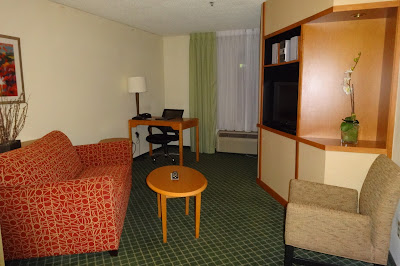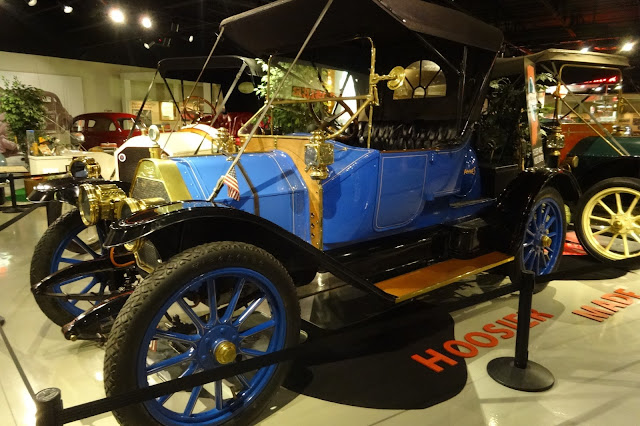 The next morning was still cold and windy, but at least the rain had stopped. We headed to the Studebaker National Museum for another day of cars. This building also houses the Center for History museum.
The next morning was still cold and windy, but at least the rain had stopped. We headed to the Studebaker National Museum for another day of cars. This building also houses the Center for History museum. We started with the Studebaker National Museum. As we entered the showroom on the first floor, the story began...
John Studebaker and his wife raised 10 children. Although he was a gifted blacksmith and woodworker, he was not a good businessman. Many people owed him money until he eventually had to close his business and move to South Bend. He built a Conestoga wagon to move his family. In 1852, Henry and Clement Studebaker opened the H & C Studebaker blacksmith shop in South Bend, IN. The Studebaker Brothers Manufacturing Company was born when the 2 younger brothers joined their brothers. This company became the world's largest manufacturer of wagons and buggies.
The display boards on the wall explained the beginnings, complete with a blacksmith shop and the sounds of the blacksmith working.



 |
| 1919 "Izzer" Buggy, pictured, last buggy manufactured by Studebaker |
 |
| 1857 Studebaker Phaeton |
 |
| 1863 Hearse |
 |
| 1905 Sleigh |



The historic and Presidential carriages were on display at the back of the showroom in their own special section. The details and descriptions were very informative.
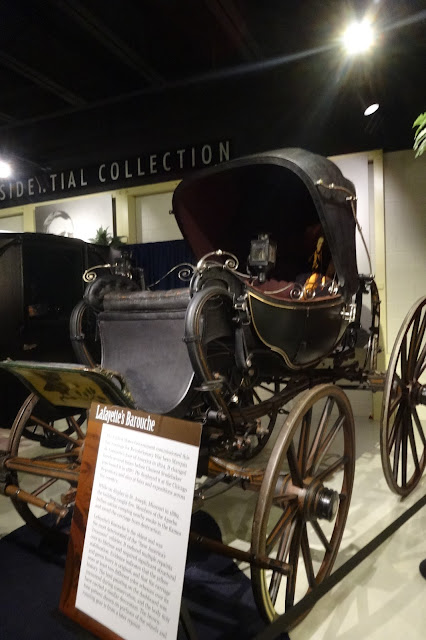






In 1902, the Studebaker Brothers Manufacturing Company produced an electric car and began their automobile production. Thomas Edison purchased the second electric car that Studebaker made. Studebaker electric cars were produced in Detroit while the horse drawn carriages continued in South Bend.
 |
| 1907 Electric Runabout |
 |
| 1911 Electric Coupe |
In 1904, Studebaker introduced its first gasoline powered car, the Studebaker Model C.
In 1911, the company's name changed to The Studebaker Company after acquiring the Everitt-Metzker-Flanders Company of Detroit. Horse drawn carriage production ended in 1920 so the automobile production began to shift from Detroit back to South Bend.
 |
| 1910 E.M.F. "30" Touring |
The 1913 models were the first time Studebaker introduced 6-cylinder engines. These were known for their exceptional ruggedness and reliability.


Many funeral homes used special children's hearses in the early 1920s due to high infant mortality. The hearses were white to represent a child's innocence. This is the only Studebaker hearse left (that is known to exist) and is believed to only be used in 1 funeral.

By 1927, Studebaker launched many new lines, including Dictator, Commander, and President.
 |
| 1927 President Limousine |
 |
| 1932 President St. Regis Brougham |
 |
| 1928 Commander Roadster |
 |
| 1925 Big Six Duplex Phaeton |
 |
| 1924 Light Six |
 |
| 1933 Speedway President ( "Speedway" refers to Indianapolis Motor Speedway) |
 |
| 1935 President Convertible Sedan |
 |
| 1931 Studebaker Six Roadster |

As we finished this first showroom, we were overwhelmingly impressed with the "showcasing" of the carriages, wagons, and automobiles with detailed scenery, setting the accurate time period. Many took quite some time to set up, but really added to the overall tone of the displays.

We learned quite a bit about the Lincoln Highway through several displays. They even had a "bench" desk with an activity for kids to complete after viewing the information and photos.

Outside the showroom, there was a special showcase room with a turning platform. There was a 1910 Marmon Speedster on the platform. It was on display to highlight the new exhibit called Hoosier Made: World Driven. The actual exhibit was in the second floor showroom so more details to come.

Next, we went down to the basement level. This was a storage area for additional cars that were not on display in the showrooms at that time. The lift system used to maximize space was quite neat.







The second floor showroom housed the exhibit called Hoosier Made: World Driven, which was created in honor of Indiana's upcoming Bicentennial. The exhibit is made of 3 parts: the "Brass Era" of the early 1900s, the "Jazz Era" of the late 'teens and early 1920s, and the "Classic" cars of the 1930s. Each of Indiana's 3 leading transportation museums (Studebaker, Kokomo, and Auburn Cord Duesenberg) are featuring one of the parts for a year as a way to celebrate the Indiana Bicentennial. The Studebaker National Museum is showcasing the "Brass Era." Since the exhibit did not officially open until November 20th, they were still adding details.



There was another section of this showroom that was devoted to design. Raymond Loewy Associates were responsible for most of the Studebaker designs after 1936.

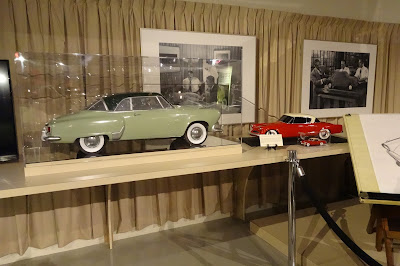
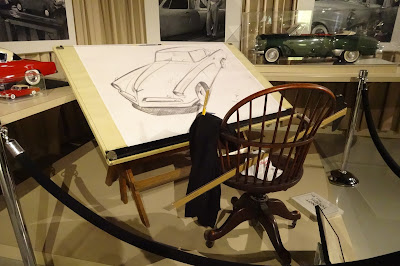
In the back of the showroom was another unique display. At the Bonnie Doon Drive-In, the details captured visitors into actually feeling like they were at the drive-in. The set was showcasing 3 special Studebaker automobiles, including a 1963 Avanti "#9," 1957 Golden Hawk 400, and a 1963 Lark Sedan.


 |
| 1963 Avanti was the first Studebaker-powered automobile to exceed 200 mph |
 |
| 1958 Packard Hawk was produced in the last year that Packard production was noted in the Studebaker-Packard merger |
 |
| Only 1947 Studebaker Champion Deluxe "Woody" Station Wagon in existence (never made it into production) |
 |
| 1964 Daytona was the last regular production Studebaker built in South Bend, IN (December 20, 1963) |
 |
| This 1966 Cruiser was the last Studebaker ever produced (March 17, 1966 in Canada) |
 |
| 1963 Zip Van |
 |
| 1928 Fire Truck |
 |
| 1964 Pursuit Marshal with kiddie car sidekick |


On the first floor, we checked out the Kid's Service Center where children are encouraged to explore various automotive tasks. Everything was child-sized and child-friendly.


The main atrium was decorated for the holiday season. Again, attention to detail was the key. It was so inviting!

As we were ready to leave the Studebaker National Museum, we were just overwhelmingly impressed by the decorative showcasing of the entire museum. One of the museum people who was obviously in charge was walking around the area, checking on different aspects of the different showrooms from sound to lighting to making sure everything was in its place. Robin asked if she could talk with him to ask about some of our questions. On many of the cars, there were signs stating who was sponsoring the cars. Robin asked if those people were responsible for the scene decorating. The museum person explained that those sponsors (individuals and/or organizations) were only responsible for financial contributions. They had expressed interest in certain cars and the museum could depend on them for money on a regular basis to pay for upkeep or anything that was needed for "their" sponsored car. He said Jay Leno was a sponsor for 2 of the cars, one of which was out on loan to another museum.

Robin told the museum person how impressed we were with the overall showcasing of the museum. Having owned our our school supply store, we had experience in showcasing merchandise, building seasonal displays, and establishing an inviting environment. We knew how much time we had devoted to those tasks. What we had done didn't even begin to compare to what we saw at this museum. The museum person explained that they had a man from South Bend who began by volunteering his time to help with displays. The man had been a window designer for one of the local department stores. After many years, the designer now works full-time at the museum, designing the displays. It was obviously a professional designer in action. Not only were there trees in just the right places, but the designer also did a fantastic job of marketing the museum's gift items throughout the displays.



We thanked our museum man and let him go back to his chores. It was time to look at the gift shop, but we would wait to make our purchases until after we had explored the Center for History museum.
We walked across the hall from the Studebaker gift shop and entered the Center for History museum. The first area was about the history of transportation.



















We drove back around to the front side of the museum so we could take some additional pictures without the mist and wind. There were also a few other Studebaker-related pictures to take, including a bed and breakfast.


Then, we went back to Tippecanoe Place to take pictures in the daylight. What a remarkable place it was!

It was lunch time and we knew exactly where we wanted to go. We had seen the world's largest chocolate shop sign painted on the back of a building in downtown South Bend. We knew we could pick up chocolate there if nothing else, but saw they had a cafe as well. Once we pulled into the parking lot, it started to snow. For Florida kids, even a snowflake falling was exciting. Even if they melted long before they hit the ground, it counted as snowing. We did eat some sandwiches, but we made bad choices. So, in order to get the bad taste out of our mouths, we had to buy some chocolate! We did read that the store was one of the world's largest chocolate shops and not necessarily THE world's largest. However, there was plenty to choose from and we did.


Our last stop before leaving South Bend was a quick trip back to The University of Notre Dame. Robin wasn't happy with her pictures of the cathedral and wanted to retake a few. However, traffic on campus was crazy. There was a football game the next day and so there were police on campus directing traffic to different points of interest.

We finally headed out of South Bend. Our final destination for the night was Merrillville, IN. We did pass a truck loaded with Christmas trees on our drive.
The sky got darker as we drove. We made a stop on the way to Indiana Dunes National Lakeshore. The Visitor Center was open, but it was getting later in the day. We stamped our passports and looked around. The temperature was quickly dropping while the wind was picking up speed and intensity. We drove out to the southern shore of Lake Michigan. Although we got out and walked closer to the beach wall, the wind was bone chilling. The waves were splashing way up and onto the shore. We took a quick look at the city of Chicago across the lake and took a few pictures before heading back to the car. If this was what "going to the beach" looked like, we would pass until we could get back to Florida's sunshine. Once back in the car, we did see one of the large dunes where hikers climbed. However, a picture was all we needed this time.




Then we went inside and were welcomed by family. Everyone was beginning to gather from out of town for Les' (Robin's cousin) memorial service the next day. We were very glad to see Arlene and the family. We checked in and took luggage to our room. Everyone was gathering in the hotel lobby area so we could visit. After a little while, we drove down the street to Portillo's Hot Dogs. We met more family there, some we hadn't seen for years. Portillo's was a new experience for us and one we found hard to maneuver. The restaurant is set up in different stations with each station's menu posted. If we didn't know what was offered, we didn't know which line to get in. We finally made a choice and got our food. The company was wonderful and we enjoyed the conversations. After dinner, we returned to the hotel lobby for more visiting. Finally, we turned in, knowing the next day would be full of emotions.

We had gotten a room with a living room so we had a place to visit. However, the lobby worked out for all of the family to gather and that was ok. Memories and family were definitely on our mind as we drifted off to sleep.
